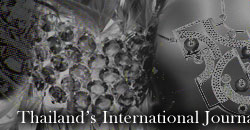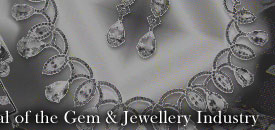| |
|
|
| |
|
 |
| |
|
| |
|
|
|
| |
Beryl is commonly associated with its two most famous forms,
emerald and aquamarine but there is more to this mineral than
that
As a matter of fact, most beryl is not even gemstone quality
and as such, its prime importance lies in its being the main industrial
source for the element beryllium, which finds application in the
nuclear and aerospace industries. Common beryl has been mined
for beryllium since as long ago as 1925.
Before we move on to a description of the gem varieties of beryl,
let us take a look at beryllium, recently infamous in gem circles
for its presence in heat-treated orange sapphires. Beryllium is
a chemical element in the periodic table and its atomic number
is 4. In its pure form, it is a steel grey, strong, light-weight
yet brittle alkaline earth metal and is used as a hardening agent
in alloys, most notably beryllium copper, which due to its electric
and thermal conductivity, high strength and hardness, non-magnetic
properties, and high corrosion and fatigue resistance finds application
in defence and aerospace for high speed aircraft, missiles, space
vehicles, communication satellites, etc. However, it must be noted
that
|
|
|
| |
Green Beryl |
|
| |
|
|
| |
Aquamarine
on Matrix with Muscovite |
|
| |
 |
beryllium and its salts are all toxic and carcinogenic (cancer
causing). The good news though, is that when it occurs as the
mineral beryl, it is harmless and can safely be worn everyday.
Beryl itself is a silicate mineral with a very unusual composition.
It forms as a ring silicate that is the silicate tetrahedra are
linked to form rings. In its pure form, it is colourless and differing
trace elements in the crystal lattice allow for its range of bright
colours without which, it would be an insipid and uninspiring
gem due to its relatively low refractive index and low dispersion
that account for its diminished brilliance.
Gem beryl is almost exclusively found in hydrothermal veins,
pegmatites or at the contacts of larger igneous instrusions that
invade aluminous schist, shale or impure limestone. Before we
move on to emeralds and aquamarines, which is what most people
think of when
|
|
| |
beryl is mentioned, let us takea look at the lesser known forms
of this gem group.
Goshenite is the name applied to a variety of clear beryls. It
is named after a deposit where it was found in Goshen, Massachusetts.
Since we have already mentioned earlier that beryl in its pure
form is devoid of colour, it is understandable if the assumption
is made that goshenite therefore is the purest form of this mineral.
However, a little known fact is that there are several elements
that can act as colour inhibitors in beryl and so the absence
of hue may be due to some impurity rather than a lack of it.
|
|
|
| |
|
| |
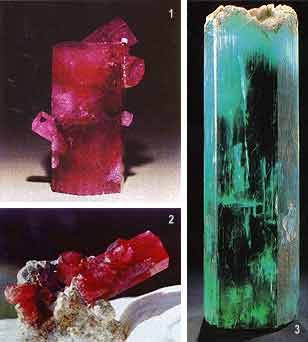
(1-2) Red Beryl (3)
Aquamarine
|
Goshenite is found in all locations where any form of beryl is
found. Its main application in the gem industry has been to use
it with metal foil to imitate the colours of emerald and aquamarine.
Due to its limited fire and lack of any attractive hue, it is
not a popular gem even though it is inexpensive. It is said that
the ancient Greeks used colourless beryl as lenses so it is possible
that the first spectacles on earth were made of beryl.
The most popular of the other beryls is morganite, which comes
in the colour range of pastel pink to peach to lavender. The colour
is due to trace amounts of manganesethat finds its way into the
crystal structure of the stone. Morganite derives its name from
that of the famous American industrialist J.P. Morgan. It was
first discovered in California's Pala pegmatites in 1905 and later
in Madagascar. There are also deposits found in Afghanistan, Brazil,
Mozambique,
|
|
| |
Namibia and Russia. Most of the material found comes from mainly
three sources: the Pala and Mesa Grande districts in San Diego,
California, the Urucum and Benanal mines in Minas Gerais, Brazil
and the Mt. Bity region in Madagascar. All are pegmatite occurrences.
Being a relatively rare stone, it does not occur in large enough
quantities like its famous cousins to build and international
market or create consumer demand for it. Therefore it is limited
to being a collector's stone. Also, stones of rich apricot and
peach colours have been known to fade to a pale pink and that
too is a minus point where desirability is concerned. The largest
faceted morganite is a approximately 600-carat cushion shaped
stone from Madagascar that is now in the collection of the British
Museum.
Heliodor or golden beryl is named after the Greek words for sun
(helios) and gift (doron). However if the stone lacks the golden
tint, it is not called heliodor but rather only yellow beryl.
Heliodor was first discovered in Namibia in 1910, in a pegmatite
that also produced aquamarine. Like Aquamarine, heliodor also
owes its colour to the presence of iron impurities in the beryl
structure. The colour ranges from pale yellow to yellow-orange
and yellow-green depending on both, the concentrations of Fe2+
and Fe3+ as well as on where these impurities are located
in the beryl crystal structure.
Beryl's crystal structure contains channels outlined by rings
of (Si-O)6 units. These rings are stacked upon one another leaving
space within the channels for water or other impurities. Colour
influencing iron impurities can be present in these interstitial
channel sites or substituting for aluminium in octahedral sites.
When Fe3+ is present substituting for aluminium in
an octahedral site, the yellow colour of heliodor is created.
When Fe2+ is present in the interstitial channel site,
a pure blue colour results. When they are both present, than we
get the typical blue-green hues of aquamarine. Heating heliodor
to 200-250 degrees Celsius can expel the Fe3+ and
Fe2+ thus eliminating the yellow colour and producing
either colourless or blue beryl. Irradiation can reverse this
process and restore the yellow colour though.
|
|
|
|
|
| |
Heliodor occurs mainly in granite pegmatities and to a lesser extent
in miarolitic cavities in granites and in greisens. It is typically
associated with quartz, feldspars and muscovite and often occurs
with other pegmatite accessory minerals like garnet, spodumene,
topaz, tourmaline, tin and tungsten minerals, etc. Because of its
relatively high hardness and specific gravity,
it is sometimes found
in
|
|
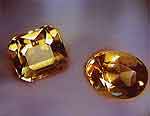
Golden Beryl |
|
| |
elluvial
and alluvial deposits. Heliodor is found mainly in Madagascar, Brazil,
USA, Russia and the Mid East countries. The largest faceted heliodor
weighs as much as 2,054 carats and is on display at the Smithsonian
Institution in Washington D.C.
The rarest form of beryl is red beryl, which goes
under the name bixbite, named after mineral collector Maynard Bixby.
Bixbite is very rare in nature and is known to occur in very few
places in the Western United States and Mexico. It was first found
in the Thomas range in Juab County, Utah in 1905. Small crystals
were found in a rhyolite host rock and although translucent were
hardly what could be described as gem material. It was only in the
1950's that larger, gem quality crystals were found in the Wah Wah
Mountains in Beaver County, also in Utah. However consistent mining
of red beryl was only undertaken from 1978.
To date, the Wah Wah claim in the only source of
gem quality bixbite and this deposit produces only a very small
quantity of this stone. Most of the stones are less than one carat
in size and most have inclusions. Clean specimens of carat plus
size are rare and prohibitively expensive. The red colour is thought
to be due to the presence of manganese substituting aluminium in
the beryl structure. Bixbite normally occurs in a type of silica
rich volcanic rocks known as "topaz bearing rhyolites".
It crystallises under conditions of low pressure and high temperature
from a pneumatolitic (gas) phase along fractures or within miarolithic
cavities and porous areas of rhyolitic magmas at or near the earth's
surface. Associated minerals are orthoclase, quartz, bixbyite, topaz,
spessartine garnet, pseudobrookite and hematite.
Emeralds of cause, are the most commonly known
beryls of all. It is said that emeralds have been cherished for
as long as there has been written history, which makes it one of
the oldest known gems of all. Archaeologists have traced its use
beyond 3000 BC, it is mentioned in the ancient Indian texts known
as the Vedas, Cleopatra is said to have valued her emeralds more
than any other gem she possessed and the ancient Romans also showed
great affinity for this green gemstone. The ancient Romans also
showed great affinity for this green gemstone. The ancient Incas
and Aztecs worshipped it as a holy stone. Incidentally, the best
emeralds are still found in South America. The most ancient occurrences
are noted to have been near the Red Sea and were famous under the
name of Cleopatra's mines. |
|
| |
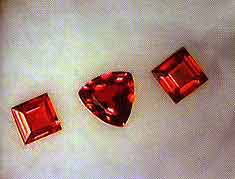
Red Beryl
|
Emerald owes its green to traces of vanadium and chrome. The fascinating
thing about this is that these elements occur concentrated in the
earth's crust at completely different locations from beryllium and
therefore logically, emeralds should not exist at all. However nature
delights in exceptions and emeralds are the happy result of extreme
tectonic processes that bring these two elements together and crystallise
them under conditions of high temperatures and enormous pressure.
Due to the manner of its genesis, emerald rarely occurs in clean
crystals especially in the larger sizes. The flaws and inclusions
are so much a part of this stone that a
vivid green coloured gem
with
|
|
| |
inclusions is preferred to one with a pale colour and
noflaws. The crystal inclusions or fissures that are typical of
emeralds are refered to by experts as "jardin", which
is French for garden. The name emerald itself derives from the
French "esmeraude", which in turn goes back via Latin
to the ancient Greek root "smaragdos" which simply means
green gemstone.
Colombia is the main country of occurrence for fine emeralds.
About 150 mining sites are known there, however not all are currently
being exploited. The most famous names in this context are Muzo
and Chivor, where even in pre-Colombian times the Incas mined
emeralds. The economically most important mine is Coscuez. Estimates
ascribe about three quarters of the current Colombian emerald
production to the about 60 locations belonging to the Coscuez
mine. Colombian emeralds are set apart from those of other origin
by their especially fine and brilliant green, which is not influenced
by any bluish tinge.
|
|
|
| |
|
|
| |
|
| |
Depending on the place
of occurrence, the colour of emerald may vary. Fine emeralds are
also found in other countries such as the Zambia, Brazil, Zimbabwe,
Madagascar, Pakistan, India, Afghanistan or Russia. Mainly Zambia,
Zimbabwe and Brazil have gained an international reputation for
fine Emeralds. From Zambia there are exported excellent emerald
crystals in a beautiful, deep emerald green showing good transparency.
Their colour is usually darker than that of Colombian stones and
often has a fine bluish undertone.
From Zimbabwe's famous Sandawana mines there come
usually smaller, but very fine emeralds in a vivid and deep green,
often with a slight yellowish-green shade. Brazil's gemstone mine
Nova Era at present even challenges the famous Colombian mines;
their production of emeralds in beautiful shades of green compete
in their attractive beauty with the gemstones offered by the neighbouring
country. Because of the occurrences found in Africa and Brazil,
emeralds are now available in larger quantities than in earlies
times.
Most emeralds are treated with oils or resins to
enhance their appearance or hide flaws but the international gemstone
trade mandates that full disclosure of these treatments must be
made when selling. |
|
| |
One of the largest emeralds in the world is the "Moghul Emerald",
whose history has been traced back to 1695. It is 10 cm. high,
weights 217.80 carats and is inscribed with prayers on one side
and engraved with flowers on the other. Christies London sold
it to an anonymous buyer for $2.2 million at an auction. Other
famous emeralds are mostly in museums or state treasuries. The
New York Museum of Natural History has a pure emerald cup said
to have been owned by the Moghul Emperor Jehangir as well as a
Colombian emerald crystal weighing 632 carats. The Bank of Bogota
has in its collection at least five emeralds weighing between
220 to 1796 carats. Their size might be rivalled by the splendour
of some truly amazing specimens in the Iranian state treasury
among which is the tiara of the last Iranian Empress Farah.
This brings us to the last of the main gems in the beryl group,
aquamarine, which literally means sea-water. It's blue-green colour
and shimmery radiance certainly live up to the name. Legend says
that it is the treasure of mermeids and a powerful charm for salilors
with more power when immersed in water. In centuries past, most
sailors did not know how to swim and the sea faring profession
was an extremely hazardous one, so a powerful charm was very welcome.
Aquamarines are usually pastel blue in colour. The darker the
colour, the better it is judged to be and a more prominent
blue
|
|
|
| |
|
|
| |
shade is preferred to
one with a greenish tint. Nothing about the beryl group is what
it seems to be. Unlike most gemstones, aquamarine actually needs
size to hold colour, that is to say that smaller stones are usually
paler than larger specimens. Unlike emerald, aquamarines are usually
free of inclusions and as mentioned earlier owe their colour to
the presence of iron in the crystal structure and the hue range
from the palest almost colourless blue to the bright shade of the
sea on a sun kissed summer day.
Most of the shades of this stone have their own
names. The different shades of Aquamarine are distinguished by their
own promising names: "Santa Maria" is the name for the
rare, intensely deep blue aquamarines found in the Santa Maria de
Itabira mine in Brazil. Similar colour are found in some of the
sparse aquamarine gemstone mines in Africa, especially in Mozambique.
In order to better distinguish them, these aquamarines are denoted
as "Santa Maria Africana". Not quite as deeply blue are
"Espirito Santo" aquamarines from the Brazilian state
of Espirito Santo. Another beautiful colour has in fact been named
in honour of a Brazilian beauty queen from 1954, and has become
famous as "Martha Rocha". Aeroides is the name given to
a pale sky-blue shade of aquamarine.
The names of the colours already point out the
importance of Brazil as the main country where aquamarines are found.
The most important source in Brazil is the state of Minas Gerais.
They are mainly found as pegmatites or as water worn pebbles or
cobbles in stream gravels. Single crystals as large as 243 pounds
have been found. In 1910, a 110.5 kg crystal was found at Maraimba
in Minas Gerais. More recently, the 26 Kg Dom Pedro was sent to
the European gem centre of Idar Oberstein to be cut by the great
gemstone artist Bernd Munsteiner.
Aquamarine is also found in Madagascar, where they
occur in medium dark blues known as "Madagascar Aqua"
Other parts of Africa like Namibia, Zimbawe, Zambia, Nigeria, etc
are also known for deep colours in untreated stones which are present
even in small specimens. Nigerian aquamarine however has a slight
greenish tinge that cannot be removed by heat treatment (most aquamarine
is subject to heat treatment after cutting so in order to get rid
of the green tints and render the stone blue) as the
colour is due to chrome rather
than iron as in the Brazilian variety. It is also
|
|
| |
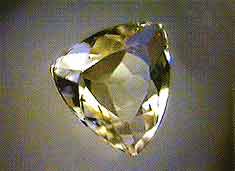
Clear Beryl
|
found in Afghanistan, Ireland, Russia, the Indian
sub-continent and the USA. An unusual type of aquamarine found
in Minas Gerais displays asterism. Some similar material is also
found in Madagscar. Cat's eye aquamarine is seldom seen on the
market.
So this then is the beryl group of minerals,
interesting and full of surprises and of course immensely beautiful.
From the rare to the easily available, they can only add to the
value of a collector's store and a deeper knowledge of these stones
can only serve to increase our appreciation of them.
|
|
|
| |
|
|

